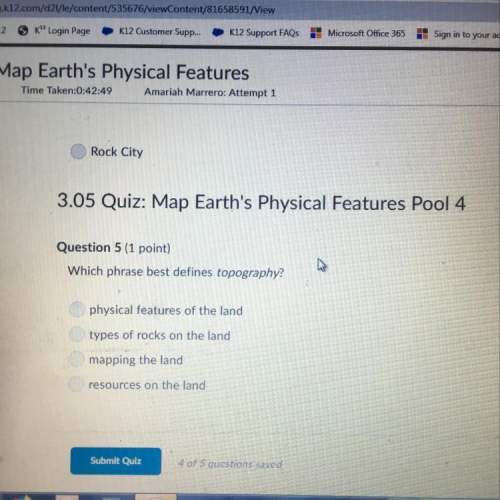A student performs the following procedure:
Procedure
1. Measure 25 grams of a...

Chemistry, 18.04.2020 23:17 luisanavarrogarcia
A student performs the following procedure:
Procedure
1. Measure 25 grams of an unknown solid.
2. Measure 200 grams of water.
3. Pour the unknown solid and water into beaker, which weighs 50 grams.
4. Stir the solution.
The student records the following observation:
Observation
About half of the unknown solid dissolves and the other half settles to the bottom of the beaker.
Part A:
The student calculated the combined weight of the unknown solid and the water to be 275 grams. Describe the mistake the student made in this calculation.
Part B:
Describe how stirring the solution will affect the total amount of matter in this investigation.

Answers: 2


Another question on Chemistry

Chemistry, 22.06.2019 23:00
What does a numerical subscript following an element in a chemical formula mean?
Answers: 1

Chemistry, 23.06.2019 02:30
What role does weathering have in shaping earth’s surface? a) it allows sediments to fall out of a medium. b) it sediments settle on a new surface. c) it breaks down older material into sediments. d) it transports sediments to a different location. will give brainliest, answer quickly.
Answers: 2


Chemistry, 23.06.2019 16:30
Match the words in the left column to the appropriate blanks in the sentences on the right. (a) this is the law of definite proportions: all samples of a given compound, regardless of their source or how they were prepared, have proportions of their constituent elements. (b) this is the law of conservation of mass: in a reaction, matter is neither created nor destroyed. (c) this is the law of multiple (c) this is the law of multiple blank: when two elements form two different compounds, the masses of element b that combine with 1 g of element a can be expressed as a ratio of small whole-numbers. in this example, the ratio of \rm o from hydrogen peroxide to \rm o from water = 16: 8 \to 2: 1, a small whole-number ratio.: when two elements form two different compounds, the masses of element b that combine with 1 g of element a can be expressed as a ratio of small whole-numbers. in this example, the ratio of o from hydrogen peroxide to o from water = 16: 8 → 2: 1, a small whole-number ratio.
Answers: 1
You know the right answer?
Questions

Mathematics, 29.08.2020 01:01





Mathematics, 29.08.2020 01:01




Spanish, 29.08.2020 01:01

Mathematics, 29.08.2020 01:01

Mathematics, 29.08.2020 01:01

English, 29.08.2020 01:01

Mathematics, 29.08.2020 01:01

Mathematics, 29.08.2020 01:01



Mathematics, 29.08.2020 01:01

History, 29.08.2020 01:01

Social Studies, 29.08.2020 01:01




